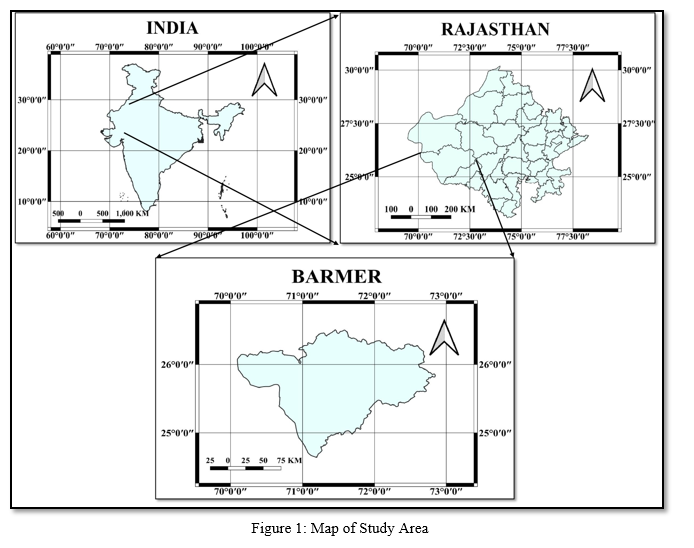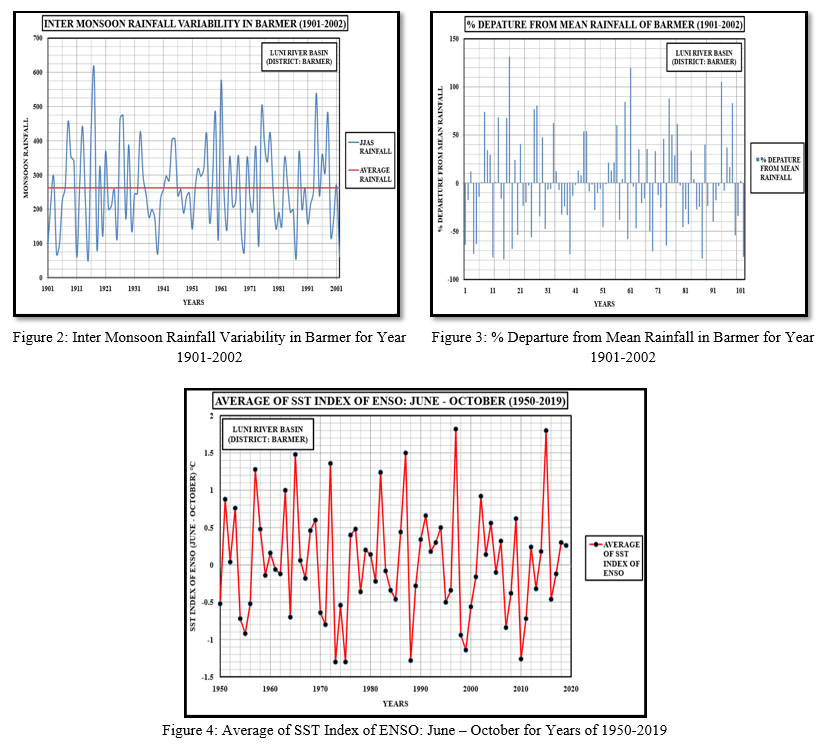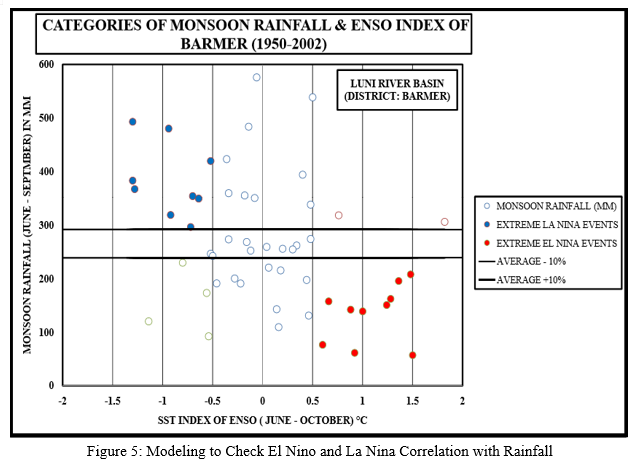Ijraset Journal For Research in Applied Science and Engineering Technology
- Home / Ijraset
- On This Page
- Abstract
- Introduction
- Conclusion
- References
- Copyright
Estimation of Fluctuations and Global Tele-connections in the Monsoonal Rainfall and Associated Floods for Barmer District
Authors: Chirag Ladavia
DOI Link: https://doi.org/10.22214/ijraset.2022.42802
Certificate: View Certificate
Abstract
This paper is about the fluctuations and global teleconnections in the monsoonal rainfall and associated floods of Barmer district, Rajasthan, India. For investigation of precipitation and related floods, the precipitation information for period of 1901-2002 is collected from India Meteorological Department (IMD) for Barmer district. Inter-monsoon rainfall variability analysis, percent departure from mean, Normalized Accumulated Departure from Mean (NADM) and conditional probability technique for El Nino and Southern Oscillation (ENSO) have been used for the analyses of monsoonal rainfall data and its effect on floods. The outcomes demonstrate year to year varieties in the precipitation with huge takeoff from mean precipitation. It is seen that greater part of the floods are related with positive takeoff from mean precipitation. The NADM shows epochal conduct of high and low monsoon precipitation of the basin. For analysis of ENSO Sea Surface Temperature (SST) data is obtained from National Oceanic and Atmospheric Administration (NOAA) for years 1950-2019. It is observed that, during La Nina years the rainfall is higher than average annual rainfall. The analysis of ENSO reveals that the probability of the occurrence of the floods is high during cold (La Nina) events and it is very low during warm (El Nino) events.
Introduction
I. INTRODUCTION
In India, rainfall is mainly occurring in four months June to September. In general the rainfall of India is too much complex to analyze and predict. The variation in intensity, duration and amount of rainfall is very high. These all factors are directly affecting floods. Therefore, it become necessary to do monsoon study of India. It is not possible to predict exact future trend of rainfall with its magnitude and duration of flood. It is only possible to study past flood for detection of proper reasons of flood.
First and biggest reason for high magnitude of flood is heavy precipitation in any basin [1]. Generally, the Indian monsoon has significant tele-connection with the sea surface temperature (SST) anomalies of the eastern and central equatorial Pacific Ocean and El Nino. Simply, the El Nino years generate situation of drought in India. In El Nino years the precipitation occur is less than average precipitation [2] [3]. Therefore, the main objective of the paper is to find out long term fluctuations and global tele-connections of the monsoon rainfall and there correlation with the floods in the Luni Basin (District: Barmer). The correlation of rainfall with ENSO is also analyzed by A. Mondal and P. P. Majumdar along with two more parameters local mean temperature and global mean temperature [10].
II. STUDY AREA AND DATA COLLECTION
Barmer district is located in the South-West Rajasthan as shown in Figure 1. It is bounded in the North by Jaisalmer district, in the North-East by Jodhpur district, South-East by Jalor district. Barmer has international boundary with Pakistan in the West direction. The location of Barmer is between 24°37’8.51” to 26°32’27.50” North latitude and 70°4’2.48” to 72°52’10.89” East longitude. Barmer district covers an approximate area of 28,551 km2.[7]
The district is part of arid climatic region. Rainfall in the district is very low as the mean annual rainfall is only 307.7 mm. Almost 90% of the total annual rainfall is received during the South-West monsoon, which enters the district in the 1st week of July and withdraws by the mid of September. The general topographic elevation in the district is between 125 m to 250 m above mean sea level. There are mainly two types of data are required to be collect. First data is monthly precipitation data for the year 1901-2002 for analyzing the pattern of rainfall. Normally, the rainfall of June to October is taken for study. The rainfall data of 1901-2002 is collected from Indian Meteorological Department (IMD). So, the accurate precipitation data of these months are required. For analysis of ENSO, Sea Surface Temperature (SST) data is required.
These data are obtained from National Oceanic and Atmospheric Administration (NOAA) for years 1950-2019. The ENSO index is average of SST anomalies over the monsoon season (June - October). The data on the basis of SST (-0.5°C and +0.5°C) were categorized into cold, warm and normal conditions. The cold years are called as La Nina years and hot years are called as El Nina years. The past data of ?oods are obtained from one article.

III. METHODOLOGY
To achieve main objective of study, the very first step is detailed monsoon study. For this purpose, collection of monthly data is done from the Indian Meteorological Department (IMD). For monsoon study, the data of monsoon season rainfall is collected, which includes precipitation data of June to September for year 1901-2002. For analysis of precipitation following graphs are generated
- Inter Monsoon Rainfall Variability
- Percentage departures from mean rainfall
The Indian summer monsoon rainfall is a very useful index of summer rainfall over the Indian region in any year [6]. This is the average of June-September rainfall of well distributed rain gauge stations across the India. It is a helpful tool of monsoon rainfall in a year.
The inter-annual and inter-seasonal variations in rainfall are signi?cant characteristics of Indian monsoon. A spatio-temporal variation in the ?oods of the Indian River basins is mainly signi?cant due to di?erences in the distributional pattern of monsoon over the Indian subcontinent during the monsoon. Similar to other monsoon dominated rivers of India, Luni River also shows signi?cant inter seasonal variation in the rainfall and ?ood events. Figure 2 shows higher precipitation variance for Barmer district. The pattern of variation in the monsoon rainfall is also described by the plots of % departure from mean rainfall, for the Barmer in Figure 3. The ordinate is the anomaly de?ned as the di?erence between ISMR of a year minus the average of rainfall of all years.
Variations in the Indian summer monsoon rainfall (ISMR) are linked with El Nino and Southern Oscillation (ENSO) phenomena [4] [5]. Therefore, it is necessary to understand connection between ENSO and rainfall while studying ?oods in the Luni Basin. The index is averaged over the monsoon season (June - October). The data on the basis of SST (-0.5°C and +0.5°C) were categorized into cold, warm and normal conditions.
For analysis of ENSO Sea Surface Temperature data is obtained from National Oceanic and Atmospheric Administration (NOAA) for years 1950-2019. Figure 4 shows the average of Sea Surface Temperature Index of ENSO for months of June to October for year 1950-2019. By doing calculation of Sea Surface Temperature (SST) and Rainfall Figure 5 can be generated, which gives the categories of the annual rainfall of the Luni Basin and ENSO index.

In Figure 5, two horizontal lines shows the deviation from mean upto ±10%. In that graph Red color dots shows the Extreme El Nino events and blue color dots shows the extreme La Nino conditions [9]. Some dots are also without color, shows normal rainfall events.

IV. RESULT & DISCUSSION
Figure 2 shows that precipitation variation of Barmer is very high, it means inter-monsoonal variability was very high. The period from 1900 to 1930 experienced greater fluctuations and the rainfall appears to be below average for many years. Inter monsoon variability was characterized by increased frequency and magnitude of floods on the Luni River mainly after 1970s.
The pattern of variation in the monsoon rainfall is also described by the plots of % departure from mean rainfall, for the Barmer in Figure 3. The ordinate is the anomaly de?ned as the di?erence between ISMR of a year minus the average of rainfall of all years [6]. The plot reveals that the rainfall sometimes varies by as much as about ±75%. Most of the ?oods in the basin were occurred when monsoon rainfall was positive from mean and very few years experienced ?oods during negative departure from mean. The analysis indicates that out of 6 major ?oods of the Luni basin 4 were occurred when rainfall was above average. It is therefore, concluded that above average monsoonal rainfall in the basin produces large ?oods. For the period under study, the mean rainfall is 262.25 mm.
Variations in the Indian summer monsoon rainfall (ISMR) are linked with El Nino and Southern Oscillation (ENSO) phenomena [8]. Table 1 indicates the conditional probability of the monsoon rainfall over Barmer given the SST Index of ENSO for years 1950-2002 (N = 53 Years). It also indicates that the probability of having high monsoon rainfall in the Luni Basin (District: Barmer) is more during cold and normal conditions (64% to 33%) and very low during warm ENSO conditions (83%).
Table 1: Conditional probability of the monsoon rainfall over Barmer for year 1950-2002
|
Rainfall |
Cold |
Normal |
Warm |
|
High |
0.64 |
0.33 |
0.17 |
|
Normal |
0.07 |
0.34 |
0 |
|
Low |
0.29 |
0.33 |
0.83 |
Table 2: Occurrence of ?oods and its relation with the annual rainfall & ENSO
|
Rainfall |
Cold |
Normal |
Warm |
|
Above Normal
|
1954 1955 1956 1964 1970 1973 1975 1988 1998
|
1958 1959 1961 1967 1976 1978 1983 1994 1996 2003 2006 |
1953 1997 |
|
Normal |
1950
|
1952 1958 1962 1979 1984 1990 1993 1995 2001 |
- |
|
Below Normal |
1971 1974 1999 2000 |
1960 1966 1968 1980 1981 1985 1986 1989 1992 |
1951 1957 1963 1965 1969 1972 1982 1987 1991 2002 |
Table 2 shows the occurrence of ?oods and its relation with the annual rainfall & SST index of ENSO for years 1950-2006. Table 2 also indicates that the frequency of occurrence of ?oods is generally high during the cold and normal rainfall years. The result of the conditional probability and occurrence of ?oods clearly indicates that all 6 major ?oods in Barmer have been occurred during normal and La Nina conditions and only 1 major ?ood occur during El Nino condition. Therefore, it can be stated that monsoon precipitation and associated ?oods of the Barmer district have signi?cant tele-connection with ENSO events.
Conclusion
The time series of monsoon rainfall indicates the remarkable inter-monsoonal variability in rainfall. Long term temporal variations in the monsoon rainfall indicates some notable years when monsoon precipitation was above (high) and below (low) average rainfall of the basin. The analysis of percent departure from mean indicates that out of 6 major floods of the Luni Basin, 4 floods were occurred when rainfall was above average. It is, therefore, concluded that above-average monsoonal precipitation in the basin produces large floods. From this paper, it is clear that occurrence of ?oods is generally high during the cold and normal rainfall years. It is also proved from the results of the conditional probability that, occurrence of all 6 major ?oods in Barmer have been occurred during normal and La Nina conditions and only 1 major ?ood occur during warm ENSO condition.Therefore, it can be stated that monsoon rainfall and associated ?oods of the Luni Basin (Barmer District) have signi?cant tele-connection with ENSO events.
References
[1] V.S. Kale, Long-period fluctuations in Monsoon floods in the Deccan Peninsula, India. Journal of Geological Society of India, v. 53, 1999, pp. 5-15. [2] E.M. Rasmussen, T.H. Carpenter, The relationships between eastern equatorial Pacific sea surface temperature and rainfall over India and Sri Lanka.Monsoon Weather Review, v. 111, 1983, 517-528. [3] J. Shukla, D.A. Paolino, The Southern Oscillation and the Longrange forecasting of summer monsoon rainfall over India. Monthly Weather Review, v. 111, 1983, 1830-1853. [4] C.F. Ropelewski, and M.S. Halpert, Global and regional scale precipitation patterns associated with the El Nino/Southern Oscillation. Monthly Weather Review, v. Ill, pp. 1987. 517-528. [5] R.P. Kane, Relationship between southern oscillation/El Nino and rainfall in some tropical and midlatitude regions. Proceedings of Indian Academy of science, v. 98, 1989, pp. 223-235. [6] Subramanya K. (2015). Engineering Hydrology, (pp. 61-63) : Mc Graw Hill Education (India) Private Limited. [7] Ground Water Department, Rajasthan (2013). Hydrological Atlas of Barmer District,Rajasthan. Barmer: National Remote Sensing Centre (NRCS), ISRO. [8] Pawar, U. V., & Hire, P. S. (2018). Department of Geography, HPT Arts and RYK Science College, Nashik, Maharashtra, India Long Term Fluctuations and Global Teleconnections in the Monsoonal Rainfall and Associated Floods of the Mahi Basin: Western India. IJSRST, 5 (1), 237-242. [9] Zhang, Y., Wallace, J.M., Battisti, D.S., 1997. ENSO-like interdecadal variability: 1900-93. J. Climate 10, 1004-1020. [10] Arpita Mondal, P. P. (2015). Modeling non-stationarity in intensity, duration and frequency of extreme rainfall over India. Journal of Hydrology, 217-231.
Copyright
Copyright © 2022 Chirag Ladavia. This is an open access article distributed under the Creative Commons Attribution License, which permits unrestricted use, distribution, and reproduction in any medium, provided the original work is properly cited.

Download Paper
Paper Id : IJRASET42802
Publish Date : 2022-05-16
ISSN : 2321-9653
Publisher Name : IJRASET
DOI Link : Click Here
 Submit Paper Online
Submit Paper Online

